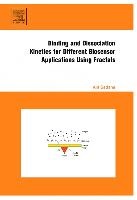Read more
Klappentext The application of biosensors is expanding in different areas. These are portable and convenient devices that permit the rapid! accurate! and reliable detection of analytes of interest present either in the atmosphere or in aqueous or in liquid phases. The detection of glucose levels in blood for the effective management of diabetes is one. Though different biosensors have been designed for an increasing number of applications! the kinetics of binding (and dissociation) of analytes by the receptors on the biosensor surfaces has not been given enough attention in the open literature. This is a very important area of investigation since it significantly impacts biosensor performance parameters such as stability! sensitivity! selectivity! response time! regenerability! etc. Binding and Dissociation Kinetics for Different Biosensor Applications Using Fractals addresses this critical need besides helping to correct or demonstrate the need to modify the present software available with commercial biosensors that determines the kinetics of analyte-receptor reactions on biosensor surfaces. * first book to provide detailed kinetic analysis of the binding and dissociation reactions that are occuring on the biosensor surface * addresses the area of analyte-receptor binding and dissociation kinetics occurring on biosensor surfaces * provides physical insights into reactions occuring on biosensor surfaces Zusammenfassung Provides detailed kinetic analysis of the binding and dissociation reactions that are occuring on the biosensor surface. This book addresses the area of analyte-receptor binding and dissociation kinetics occurring on biosensor surfaces. It provides physical insights into reactions occurring on biosensor surfaces. Inhaltsverzeichnis 1. Introduction 2. Modeling and Theory 3. Fractal Analysis of Toxin and Pathogen Detection on Biosensor Surfaces 4. Fractal Binding and Dissociation Kinetics of Heart-Related Compounds on Biosensor Surfaces (cholesterol oxidase! digoxin (digitalis)! G-protein coupled receptors! heparin-protein interactions) 5. Fractal Analysis of Binding and Dissociation Interactions of Cancer Markers on Biosensor Surfaces (putrescine! bovine troponin I (cTnI)) 6. Fractal Analysis of Binding and Dissociation of Autoimmune Disease Markers on Biosensor Surfaces (diabetes! systemic lupus erythomatosus (SLE)! arthritis! others) 7. Fractal Binding and Dissociation Kinetics of Prion Proteins on Biosensor Surfaces 8. Fractal Analysis of Binding Interactions of Environmental Contaminants on Biosensor Surfaces 9. Fractal Analysis of Proteins Involved in Drug Design on Biosensor Surfaces (cyclotides: kalata B1and kalata B6). 10. Fractal Analysis Of Binding And Dissociation Kinetics of Analytes on Sol Gel Surfaces used as Biosensors 11. Fractal Analysis of Binding and Dissociation Kinetics of Analytes on Novel Biosensors(diffraction based sandwich immunoassay! modular biosensor! near IR carbon nanotube sensors! fluorescent renewable immunoassay) 12. Fractal Analysis of Different Compounds Binding and Dissociation Kinetics on Biosensor Surfaces (alkaline phosphatase! glutathione! human chorionic gonadotropin) 13. Market Size and Economics for Biosensors ...

